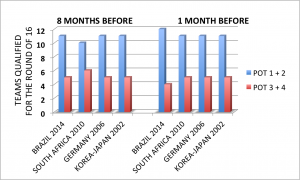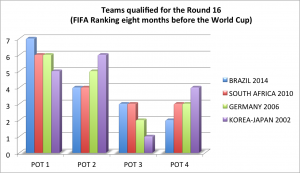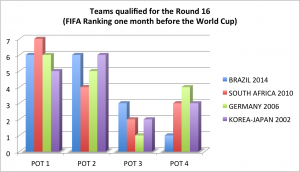November 17th, 2017
The 32 teams of the World Cup Russia 2018 have been defined. Half of them will qualify for the Round of 16. Who will those teams be? Can mathematics give us the answer? It is said that in soccer there is no logic because the favorite team can be eliminated or the weaker team can give a surprise. It is true! It has happened in previous World Cups. In Korea-Japan 2002, France was ranked #1 in the FIFA ranking, they had achieved the World Cup 4 years ago, but in East Asia they were eliminated with a single point. The same happened in Brazil 2014… Spain, being the most powerful team (# 1 in the FIFA ranking), ended up third in the Group Stage and said goodbye to the World Cup. These things happen, it’s soccer! However, the same pattern is repeated in each World Cup. There will be teams that will give surprises and others that will give disappointment. What does it mean? That there is a trend! And if there is a tendency… there is a prediction. In this article we will explore some concepts of central tendencies and with this we will predict the teams that will qualify for the Round of 16.
The World Cup Russia 2018 is presented as the first one to draw the Groups based on the FIFA ranking; that is, the 32 teams are grouped in 4 pots according to that ranking, the best go to pot 1, the weakest to pot 4. More details about the draw can be found here. In previous World Cup events the pots were grouped by Confederations, not by ranking; therefore, a powerful team could have had the luck to face the weakest teams of each Confederation or the misfortune to fall into the “Group of Death.” In Russia it will not be like that, the Groups will be fair; however, this will not affect the fact that there will still be surprises in the games, because these are born in soccer itself and not in the order of the Groups.
To predict some statistical trend we will consider the mathematical model called “FIFA ranking.” Details of the model appear here. Since we are 8 months away from the World Cup, we will consider the results of October and in the future we will update this article with the ranking given in May 2018 (1 month before the World Cup). We will do the same with previous World Cups, grouping them in 4 pots according to the ranking of those years and we will see how many teams of each pot qualified to the Round of 16. The results are detailed in the supplementary information.
Here we show the final conclusions:

In Chart 1 we note that for all the World Cups in question, whether using the FIFA ranking of October (8 months before the World Cup) or May (1 month before the World Cup), most teams that qualify for the Round of 16 come from pots 1 and 2; that is, the best teams in the FIFA ranking. From here we can obtain the arithmetic mean of the 16 teams advancing to the next round. We have:
| Arithmetic mean | |
| Pot 1 + 2 = 11/16 = 68.75% | Pot 3 + 4 = 5/16 = 31.25% |
The arithmetic mean is probably one of the most widespread and easy to use statistical parameters, it is enough to add the values in each World Cup and divide them by the total number of World Cups (4 in our case). Let’s see now the behavior in each pot:


Regardless of the date of the FIFA ranking (Chart 2 or Chart 3), the mode of pot 1 is 6 and of pot 4 is 3. That is, 6 and 3 are the most frequent values in each pot. Moreover, the airthmetic mean gives a similar result:
| Teams that qualify for the Round of 16 (arithmetic mean) | ||
| POT | 8 months before the World Cup (FIFA Ranking) |
1 month before the World Cup (FIFA Ranking) |
| 1 | 75% (6 teams) | 75% (6 teams) |
| 2 | 59.4% (5 teams) | 65.6% (5 teams) |
| 3 | 28.1% (2 teams) | 25% (2 teams) |
| 4 | 37.5% (3 teams) | 34.4% (3 teams) |
These data allow us to forecast the outcome in Russia 2018:
- Will qualify for the Round of 16, 11 ±1 teams of pots 1 and 2.
- Will qualify for the Round of 16, 5 ±1 teams of pots 3 and 4.
- It it likely that the qualified teams of pot 1 outnumber those of pot 2.
- Interestingly, it is likely that the number of qualified teams of pot 4 is greater than pot 3.
In the World Cup Russia 2018, the pots, according to the FIFA ranking for the month of October, are grouped as follow:
| POT 1 | POT 2 | POT 3 | POT 4 |
| 1. Germany | 10. Peru | 21. Iceland | 41. Nigeria |
| 2. Brazil | 11. Switzerland | 22. Costa Rica | 43. Australia |
| 3. Portugal | 12. England | 25. Sweden | 44. Japan |
| 4. Argentina | 13.Colombia | 28. Tunisia | 48. Morocco |
| 5. Belgium | 16. Mexico | 30. Egypt | 49. Panama |
| 6. Poland | 17. Uruguay | 32. Senegal | 62. South Korea |
| 7. France | 18. Croatia | 34. Iran | 63. Saudi Arabia |
| 8. Spain | 19. Denmark | 38. Serbia | 65. Russia |
As you can see, Russia belongs to pot 4. You should not confuse the order given for the group phase draw with this one. In the first one, the host Russia belongs to pot 1, in this case we are grouping the teams strictly according to the FIFA ranking. In yellow we highlight the teams that we believe will qualify for the Round of 16, the number of teams from each pot are given taking into account the statistical trend with a margin of error of ± 1, the chosen teams are just pure speculation, but with something we have to start
In December is the FIFA final draw to determine the Group stage, these Groups will allow us to glimpse new trends, and in May 2018, the mathematical model of FIFA will give us a new ranking. For those dates we will update the article giving greater strength to the forecast. The teams may change but the trend will remain… we are already convinced of that.
Christian Ortiz PhD
